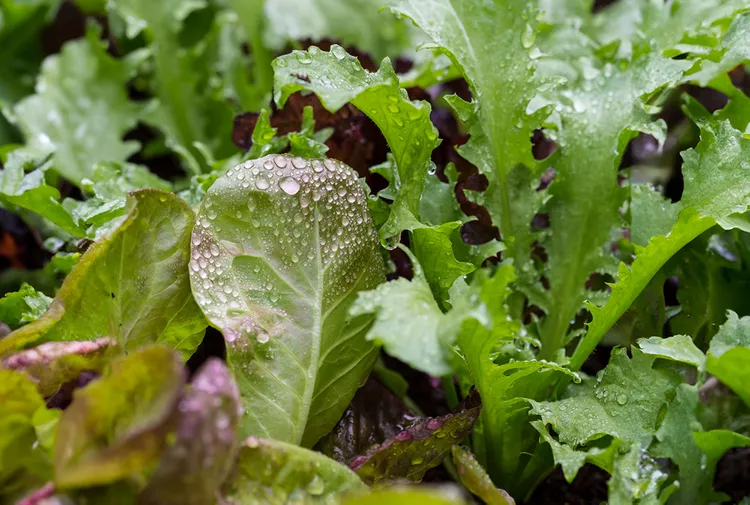Longing for five-minute-fresh lettuce from garden to plate? Seed catalogs offer a dizzying selection when it comes to different types of lettuce. Plant breeders have been working hard on lettuce for good reason—it’s a popular veggie with home gardeners and a profitable crop for market growers. Here are some of the best types of lettuce to plant this year to add crunch and color to your salads.
Choosing Lettuce Types
Lettuces are often divided into three main groups: loose-leaf, head, and romaine. They are also categorized by when they’re harvested: baby leaf, mini, or full-sized heads. For example, most butterhead lettuces are intended to be harvested at mature size, while oakleaf lettuces are well-suited for baby leaf harvest.
Lettuces are quick-to-mature crops, so you can experiment with a few different kinds. Most gardeners grow several varieties to provide a mixture of taste, appearance, and texture. Trying different types of lettuce is part of the fun of growing your own.
Lettuce seed is available pelleted or raw (just the naked seed). The pelleted seed is coated with a material, usually clay, to make it larger, more uniform, and easier to plant. Either type of seed is suitable for home gardeners.
1. Best Loose-Leaf Lettuces
As the name suggests, loose-leaf lettuce types have an open, loose form. The tender leaves are often ruffled and can be harvested singly off the main stem. This allows the rest of the plant to continue growing and producing more leaves.
- ‘Bauer’ has sturdy leaves held relatively high off the ground, which might help your outdoor-grown lettuce stay cleaner.
- ‘Black Seeded Simpson’ has a mild flavor and appealing ruffled green leaves. It is an excellent and reliable early spring grower.
- ‘Red Sails’ is an award-winning red leaf lettuce that makes an attractive contrast with other green salad ingredients.
2. Best Head Lettuces
In contrast to loose-leaf types of lettuce, the leaves of head lettuces grow closely together, forming a tight “head” that is typically harvested all at once.
- ‘Nancy’ is a butterhead lettuce with thick leaves, a bright green color, and a dense heart.
- ‘Parris Island’ is a romaine lettuce with sweet, mild leaves that can reach 12 inches long. They’re perfect for making lettuce wraps.
- ‘Sunland’ is a compact romaine variety with tight heads ideal for recipes that call for hearts of romaine. As the name suggests, this variety is heat tolerant.
3. Best Mini Head Lettuces
More compact and faster-maturing than regular head lettuce varieties, mini head lettuces offer tender bundles of leaves that are just the right size for a single salad. Up the flavor factor by tossing them on the grill for a few minutes.
- ‘Kolibri’ is an early maturing bibb variety (43 days) with speckled green leaves. It is less picky about soil moisture and has a beautiful shape.
- ‘Cegolaine’ makes dense, bronze-colored, ruffled heads that are slow to bolt and disease resistant. This lettuce can be sown in spring, summer, or fall.
- ‘Rosaine’ is a deep red mini-head lettuce with a green heart. It has high resistance to downy mildew.
4. Best Types of Lettuce for Containers
A large harvest of lettuce can grow in a surprisingly small space on your balcony, the front steps, or on your patio. Choose containers at least 8 inches deep and with good drainage. Place them in a spot near your garden hose for easy watering and where the plants receive four or more hours of sunshine per day.
- ‘Mascara’ is a red-tinged oakleaf lettuce that does best in cooler weather. It’s a cut-and-come-again loose-leaf type with a mild flavor.
- ‘Little Gem’ grows small, one-salad-sized heads with a verdant green color.
- ‘Freckles’ is suitable for harvesting as baby leaves or small heads. Compact plants are spring-green with crimson speckles.
Beware the Bolt
Lettuces are cool-season crops that bolt (send up a flower stalk) in hot weather. Bolted lettuce often turns bitter. Bolt-resistant or heat-tolerant lettuce varieties do better in the warmer months, but even they eventually bolt. Remove the plants at this point or let them flower and collect the seeds to plant next season.




















